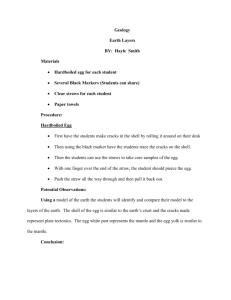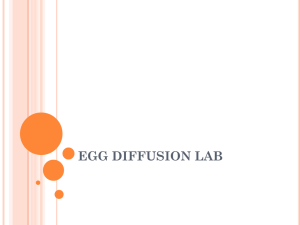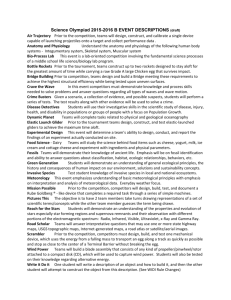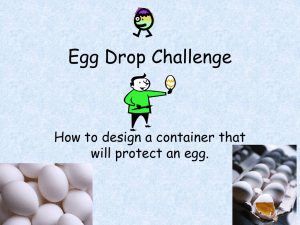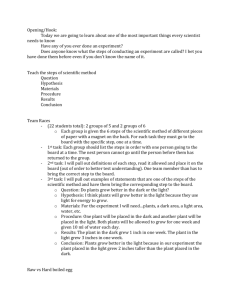Osmosis Lab
advertisement
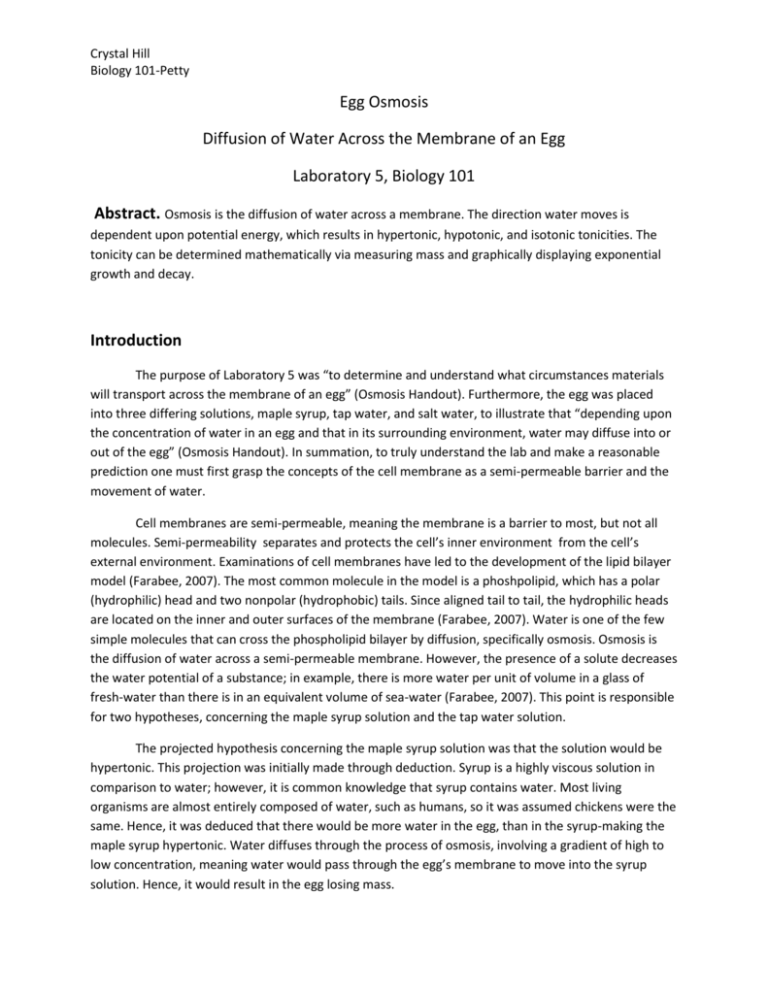
Crystal Hill
Biology 101-Petty
Egg Osmosis
Diffusion of Water Across the Membrane of an Egg
Laboratory 5, Biology 101
Abstract. Osmosis is the diffusion of water across a membrane. The direction water moves is
dependent upon potential energy, which results in hypertonic, hypotonic, and isotonic tonicities. The
tonicity can be determined mathematically via measuring mass and graphically displaying exponential
growth and decay.
Introduction
The purpose of Laboratory 5 was “to determine and understand what circumstances materials
will transport across the membrane of an egg” (Osmosis Handout). Furthermore, the egg was placed
into three differing solutions, maple syrup, tap water, and salt water, to illustrate that “depending upon
the concentration of water in an egg and that in its surrounding environment, water may diffuse into or
out of the egg” (Osmosis Handout). In summation, to truly understand the lab and make a reasonable
prediction one must first grasp the concepts of the cell membrane as a semi-permeable barrier and the
movement of water.
Cell membranes are semi-permeable, meaning the membrane is a barrier to most, but not all
molecules. Semi-permeability separates and protects the cell’s inner environment from the cell’s
external environment. Examinations of cell membranes have led to the development of the lipid bilayer
model (Farabee, 2007). The most common molecule in the model is a phoshpolipid, which has a polar
(hydrophilic) head and two nonpolar (hydrophobic) tails. Since aligned tail to tail, the hydrophilic heads
are located on the inner and outer surfaces of the membrane (Farabee, 2007). Water is one of the few
simple molecules that can cross the phospholipid bilayer by diffusion, specifically osmosis. Osmosis is
the diffusion of water across a semi-permeable membrane. However, the presence of a solute decreases
the water potential of a substance; in example, there is more water per unit of volume in a glass of
fresh-water than there is in an equivalent volume of sea-water (Farabee, 2007). This point is responsible
for two hypotheses, concerning the maple syrup solution and the tap water solution.
The projected hypothesis concerning the maple syrup solution was that the solution would be
hypertonic. This projection was initially made through deduction. Syrup is a highly viscous solution in
comparison to water; however, it is common knowledge that syrup contains water. Most living
organisms are almost entirely composed of water, such as humans, so it was assumed chickens were the
same. Hence, it was deduced that there would be more water in the egg, than in the syrup-making the
maple syrup hypertonic. Water diffuses through the process of osmosis, involving a gradient of high to
low concentration, meaning water would pass through the egg’s membrane to move into the syrup
solution. Hence, it would result in the egg losing mass.
Crystal Hill
Biology 101-Petty
The second hypothesis concerned the egg in the tap water. The logic behind the hypothesis
came from the thought sequence that tap water is entirely water, and the minerals found inside are
negligible. Even though the chicken egg is mostly water, “mostly” water is not “entirely” water. So, it
was predicted that tap water would hypotonic in relation to the egg, and the egg would gain mass from
water being passed into the egg.
Also, water has the tendency to move from an area of higher concentration to one of lower
concentration. In essence, water molecules move according to differences in potential energy between
where they are and where they are going (Farabee, 2007). This point is specifically responsible for the
hypothesis concerning salt water, in relation to the egg. Even though salt is used as preservative in food,
it preserves food by drawing out moisture, meaning it has a greater energy than most molecules
responsible for moisture in food-particularly water. Hence, it was assumed that saltwater would prove
to be hypertonic, in comparison to egg #3.
Methods
The materials given were three raw chicken eggs, vinegar, maple syrup, tap water, and table
salt. Prior to beginning the experiment, the raw chicken eggs were saturated in vinegar for two days, in
order to remove the outer shell. Also before beginning the experiment, the mass of the glass dish was
obtained, via a triple beam balance, for measuring/zeroing purposes.
On the day of the experiment, the three raw eggs were removed from their vinegar bath and
rinsed under a stream of tap water, running from a faucet. After rinsing, each egg was patted dry, placed
in a glass dish, and measured b y a triple beam balance, in order to obtain the initial mass of the egg.
Once the mass of each egg was recorded, each egg was assigned to an individual cup. Once in their
designated cups, a different solution was poured into each cup. The amount poured was just enough to
cover the surface of each egg. Maple syrup was poured into one cup containing an egg. Tap water was
poured into the second cup, containing the second egg. Saltwater, made by combining an unspecified
amount of table salt and tap water, was poured into the third cup, which contained the third egg.
33 Minutes after being submerged in maple syrup, observations regarding egg #1 (the egg
submerged in maple syrup), were recorded. Then, the egg was removed from its solution, rinsed in tap
water, and placed in a glass. Once in the glass dish, the dish was placed on a triple beam balance, and
the final mass was measured and recorded. 29 Minutes after being submerged in tap water,
observations pertaining to egg #2 (the egg submerged in tap water) were recorded, and the egg was
removed from its solution, and placed in a glass dish, to be placed on the triple-beam balance. Once on
the triple-beam balance, the final mass of egg #2 was measured and recorded. 28 Minutes after being
covered in saltwater, observations of egg #3 (the egg submerged in saltwater) were made and recorded.
After which, egg #3 was removed from the saltwater solution and rinsed under a stream of tap water. In
continuum, egg #3 was placed in a glass dish, and then placed on a triple-beam balance, from which its
final mass was obtained. Once obtained, the final mass of egg #3 was recorded.
Crystal Hill
Biology 101-Petty
Results
Understanding that the experiment involved determining the tonicity of various solutions,
through the observation of a change in mass over a period of time, one can illustrate the change in mass
as exponential growth or exponential decay. Exponential growth is characterized by the standard
formula𝑦 = 𝐴𝑒 𝑥𝑡 , where A is the initial amount (initial mass of the egg), x is equated to the rate of
change (gram per minute), t is time, and y is the amount (mass of the egg) at a certain point in time. For
exponential decay, the standard formula is the same, however x is negative (-x), due to a decrease in
grams per minute, 𝑦 = 𝐴𝑒 −𝑥𝑡 . The smaller the absolute value of x, the more time needed to see change
in the mass of the egg, meaning the mass of the egg doesn’t really change unless t is significantly large.
X for Figures 2 through 4 was derived, by using the egg’s initial mass found in Figure 1 (“Egg’s
Mass Before Submergence”) as A and y was substituted with the “Egg’s Mass After Submergence”, also
found in Figure 1. T was replaced with the number of minutes under “Total Time of Submergence”
(Figure 1). Once, each variable, besides x was replaced with a numerical value from Figure 1, solving for
the x value was possible. Also, it is important to understand that whether x is positive (+) or negative (-),
is also “figured out” when solving for x, and not before.
The graph of Egg #1 (Figure 2), the egg placed in maple syrup, had a negative x value, from
which it is understood, the graph of Egg #1 is expressing exponential decay, meaning the syrup was
either hypertonic or isotonic. To determine if solution was either is dependent upon the absolute value
of x. 0.016177 ≈0.02 was actually fairly large, considering it was a proportion/fraction of grams per
minute. In application, this means maple syrup was hypertonic, because significant change in mass
dependent upon x, and not a significantly large amount of time (t). The fairly large x value also accounts
for the steepness in the graph of Figure 2, which is not as present in Figure 3 and 4.
Figure 3, the illustration of the growth in mass of Egg #2 (the egg submerged in tap water), has a
growth rate (x) of 0.00081911 grams per minute. In this solution, x is positive, so the egg gained mass,
meaning the solution was either hypotonic or isotonic, dependent upon the significance of the absolute
value of the growth rate, which is similar to 0.001. This value is small, and it means that the growth is
more dependent on a large amount of time, which explains that even over a large time interval ( 800
mins., the maximum axis value in the t-domain) the graph is almost linear. Hence, it is mathematically
correct to understand that the tap water solution is isotonic.
Egg #3 was suffused in tap water. The illustration of its decay is present in Figure 4, because the
exponential growth in mass for Egg#3 has a growth rate of x= -0.0010061 grams per minute. Tap water
solution is either hypertonic or isotonic. Again, a rate ≈ 0.001 is small, and the change of initial mass is
dependent upon a significantly large t. To illustrate/predict significant exponential decay, the t-domain
continues to 2000 mins ( 33 hours and 33 minutes). Once more over the scope of time, the solution is
proven to be isotonic.
Crystal Hill
Biology 101-Petty
In-Lab Data Table
Substance
Egg
Submerged
in
Total Time of
Submergence
Egg’s Mass
Before
Submergence
Egg’s Mass
After
Submergence
Increase/Decrease
in Egg’s Total Mass
Syrup
33 mins.
Decrease
87.5g
50.25g
(10:40 AM11:13 AM)
ΔGrams = -37.25
29 mins
Increase
Tap Water
104.0 g
106.5g
(10:44 AM11:13 AM)
ΔGrams = 2.5
28 mins.
Decrease
Saltwater
64.8g
(10:45 AM11:13 AM)
63.0g
ΔGrams = -1.8
Observations
of Egg Before
Placed in
Solution
Relatively
smooth;
transparent
with large
yellow center
Relatively
smooth;
transparent
with large
yellow center
Relatively
smooth;
transparent
with large
yellow center
Observations
of Egg After
Removed
from
Substance
Darker
coloration;
shrunken
Swollen;
transparent
with large
yellow center
White; dry;
rough to the
touch
Figure 1.
Growth and Decay Graphs of each egg according to Mass (grams) v. Time (minutes)
Formula for decay in mass of Egg #1 with respect to time: 𝑦 = 85.7𝑒 −0.016177𝑡
Mass of Egg #1 v. Time
Crystal Hill
Biology 101-Petty
Mass
(grams)
Time
(minutes)
Figure 2.
Formula for decay in mass of Egg #2 with respect to time: 𝑦 = 104.0𝑒 0.00081911𝑡
Mass of Egg #2 v. Time
Mass
(grams)
Figure 3.
Time
(minutes)
Formula for decay in mass of Egg#3 with respect to time: 𝑦 = 64.8𝑒 −0.0010061𝑡
Mass of Egg#3 v. Time
Crystal Hill
Biology 101-Petty
Mass
(grams)
Time
(minutes)
Figure 4.
Discussion
The immediate findings in the lab that gave the “Increase/Decrease in the Egg’s Total Mass”
(Figure 1) suggested that three of the projected hypothesis were correct. The projected hypothesis
concerning the maple syrup solution was:
The maple syrup solution would prove to be hypertonic.
This projection was initially made through deduction. Syrup is a highly viscous solution in comparison to
water; however, it is common knowledge that syrup contains water. Most living organisms are almost
entirely composed of water, such as humans, so it was assumed chickens were the same. Hence, it was
deduced that there would be more water in the egg, than in the syrup-making the maple syrup
hypertonic. Water diffuses through the process of osmosis, involving a gradient of high to low
concentration, meaning water would pass through the egg’s membrane to move into the syrup solution.
Hence, it would result in the egg losing mass.
The immediate findings from Figure 1, show that Egg #1, did lose mass (Δgrams=-37.25). So, the
hypothesis was supported by the in-lab data. However, the in-lab data is somewhat crude, because it
does not provide a rate of change in the mass, besides using more than 2 sets of data. Correct/ accurate
data should also allow one to make predictions. How can one make a valid prediction with only 2 known
facts?
Mathematically analyzing the data (Figure 2 though 4) allows one to make a prediction and also
verify that significant change is actually occurring. The graph in Figure 2 confirms that the data given is
actually in the form of growth/decay by the shape of the graph and by the rate of decay. It also allows
one to make predicts for specific point in time, due to the mathematical schematic of input of a time
and the output of a corresponding mass. By mathematical analysis, the assumption that the maple syrup
was hypertonic, in comparison to the egg, was supported.
Crystal Hill
Biology 101-Petty
The second hypothesis concerned the egg in the tap water. The logic behind the hypothesis
came from the thought sequence that tap water is entirely water, and the minerals found inside are
negligible. Even though the chicken egg is mostly water, “mostly” water is not “entirely” water. So, it
was predicted that tap water would hypotonic in relation to the egg, and the egg would gain mass from
water being passed into the egg. The “In-Lab Data”, supported this hypothesis by showing that the egg
increased in mass, from 104.0g to 106. 5 grams (Figure 1). However, once the data was mathematically
analyzed and plotted, the hypothesis was rejected.
The assumed growth in mass that is necessary is not entirely proven mathematically (Figure 3).
The rate of exponential growth (x≈0.001) is not at all significant. In fact, it barely produces an illustration
of growth. Growth by is characterized exponentially not linearly, which Figure 3 is a closer
representation of. Since, the graph has a slight curvature, which can only be attributed to the limit of
the time domain, it is probable that, if the graph was only viewed on a time domain of {t|0 ≤ t ≤ 100},
the illustration would be linear. Ergo, the data is not sufficient evidence to prove growth or decay. It
does prove, that A never varied enough to produce actual growth. This analysis does support that the
tap water solution is isotonic to the egg, nullifying the projected hypothesis.
Lastly, the hypothesis made in relation to the saltwater was also based on logical deduction.
Even though salt is used as preservative in food, it preserves food by drawing out moisture. Hence, it
was assumed that saltwater would prove to be hypertonic, in comparison to egg #3. Figure 1 shows that
egg #3 loss mass ( Δgrams=-1.8) and had a final mass of 63g. Yet, mathematical analysis would once
more reject the hypothesis.
When projected into a graph (Figure 4), the data obtained resulted in an exponential growth
rate ≈ 0.001 grams per minute. This growth rate is not significant at all, and the curvature of the graph is
primarily because of time and not a rate of change. Also, if the graph was only projected from {t|0 ≤ t ≤
250}, the graph would resemble a more linear equation, meaning A, the initial mass does not change
significantly enough to qualify the solution as either hypertonic or hypotonic. At best, one might say that
the solution is isotonic to the egg. However, that would leave the loss of mass to be explained. My
hypothesis was not accepted, because overall, the date was inconclusive.
In terms of improving the lab, science, including biology, goes hand-in-hand with math. To prove
a concept, the data should be clearly supported by quantitative analysis. Also, an experiment is
supposed to be designed in such a way that it can be reproduced or replicated elsewhere. Tap water
varies by location; this could possibly affect results, due to different mineral concentrations in another
locations. Also, scientifically, time is measured in seconds for the metric system, which uses grams for
mass. A single standard system should be used to calculate data. Minutes and pounds are used within
the American Standard System. Pound, however, is a force, not a measure of mass. Seconds and grams
are used within the SI System.
Crystal Hill
Biology 101-Petty
Conclusion
The visualization of diffusion aided one in understanding cell transport across the cell
membrane, specifically passive transport concerning the osmosis of water. Through the defining of the
hypertonic, isotonic, and hypotonic and the measuring of mass to represent quantitative data to
demonstrate increase/decrease of water, it was possible to easily grasp the concept of passive
transport. If the egg gained a substantial amount of mass over specific period time, the solution it was
placed in would be considered as hypotonic in relation to the egg. If the egg loss a substantial amount of
mass over a specific time period, the solution the egg was placed in would be considered hypertonic, in
relation to the egg. If the egg neither gained nor loss mass, after being placed in a solution over a
specific period of time, then the solution is considered to be isotonic in relation to the egg.




